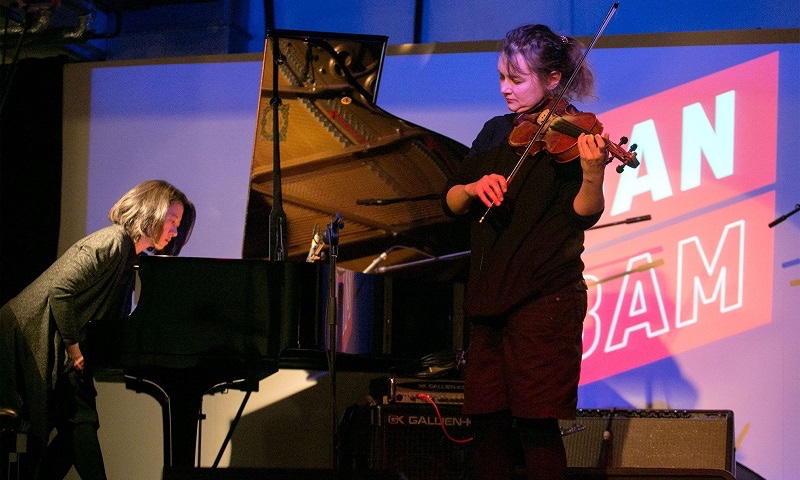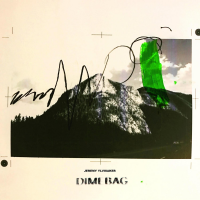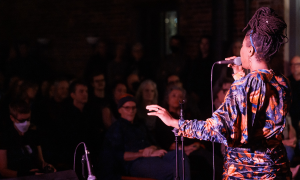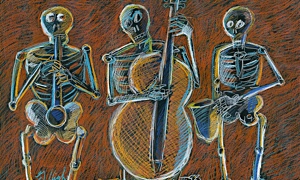Home » Jazz Articles » What is Jazz? » BAN BAM: Talking Music
BAN BAM: Talking Music

Only by showing that anything can be done by either a man or a woman can you really change the perception
—Rosella Bottone, musician, sound engineer, founder of Girls Rock Dublin
This, and many other questions related to the gender imbalance in jazz/improvised music, are put under the microscope at BAN BAM, a vibrant one-day festival of talks and music [for music review see separate article] by Improvised Music Company—the people who brought you the award-winning festival 12 Points and Down with Jazz.
BAN BAM signals an important new initiative from IMC, as the festival's Creative Producer and IMC Marketing Manager Aoife Concannon explains: "I'd become aware of the gender imbalance on stage in the last few years and we at IMC decided to take a bit of action. The first thing was to talk to the female jazz musicians in our local scene to get a feel for their perspective about their experiences, why they think there are so few girls and women pursuing careers in this sort of music and what they think could help them in their careers."
BAN BAM is a play on 'bean'—the Irish for 'woman.' It's certainly catchier than the usual 'Woman in Jazz' titles that often accompany similar events. "We want it to be a fun event, not something that sounded weighty, academic and restricting," says Concannon. Going forward the name is also more user-friendly. "If we want to do collaborations with other genres, whether it's rock, pop or whatever, then BAN Bam could still be used."
From the outset, the IMC team of Concannon, Kenneth Killeen and board member Riona Sally Hartman concurred that just putting on music for BAN BAM was not enough. "We decided that a big part of this festival would have to be conversations. Conversations on the issues around gender imbalance in jazz and improvised music is what it's all about."
There's plenty of that in the two panel discussion that get BAN BAM underway in The Complex, a multiple-studio cum performance/exhibition space run by an artists' collective, a stone's throw from the River Liffey, in the heart of Dublin.
What's Wrong With This Picture?
To set the scene, the first panel discussion is preceded by a slide presentation from Issie Barratt (jazz musician, composer, conductor and educator) that provides snapshots of her thirty-year career to date. In all the ensembles she has been involved in, whether performing, writing or conducting, there is a striking common denominator: "The only woman I've actually seen in any of that, in any capacity, was me," she states. As Head of Jazz at Trinity Laban and the National Youth Jazz Collective, Barratt also observed that the majority of students were also male. "It starts to make you think. What's going on here then?"
A multi-faceted artist, Barratt has also worked extensively in the domain of classical music, where a different picture emerges: "I notice that when I write for contemporary classical ensembles that the gender balance is much more fifty-fifty and I started to think why is that?"
Barratt's research in the UK turned up some stark figures, namely that women make up only 5% of jazz instrumentalists and that less than 5% of bands programmed at UK jazz festivals are led by a woman. She found a similar picture in education, where women make up a tiny percentage of professors in the UK's conservatoires and music colleges. Women instrumentalists are also poorly represented in the jazz media and, when all the above facts are taken together it's not a total surprise that women are heavily outnumbered by men on the shortlists for jazz awards.
A disproportionate number of women, Barret observes, lead their own ensembles: "They say it's often because they are not asked to be in other people's projects. Rhythm section players in particular say it's really difficult to get the same opportunities to be a side person as a woman."
Clearly perceptions surrounding females and music in general---and what Barratt refers to as unconscious bias in the industry—need to be better understood. There's plenty of food for thought in Barratt's presentation (a longer interview with Barratt pursuing these issues will appear presently at All About Jazz), which the opening panel wastes no time getting its teeth into.
Chicks Dig It!
The first panel, moderated by singer-songwriter Riona Sally Hartman brought together Barret, Rosella Bottone (musician, sound-engineer and founder of Girls Rock Dublin) and Matthew Berrill (musician, Galway Jazz Festival Artistic Director and educator). The themes of the discussion included education, role models and positive examples of practises within the industry.
What sort of changes, Hartman asked, can be made to improve the gender balance in jazz, and indeed across all music genres? For Barratt, the way the music is taught could be significantly refined to foster greater gender balance. "It is definitely the pedagogy; you have to take away the Alphaness out of it and make it a much more relaxed environment. That Alpha culture is a turn-off for creativity."
A subject that arose repeatedly on the panel is the importance of female role models. In Dublin, in the summer of 2016, Bottone helped launch the summer school Girls Rock, Dublin, part of a global movement that operates in over a hundred cities. At these week-long camps girls and young women can study vocals, guitar, bass, synthesizer and drums. They form bands, write songs and at the end of a week play a gig. What's amazing about these camps is that no previous musical experience is necessary. "It's kind of crazy and that's why it's exciting," says Bottone.
"Only by showing that anything can be done by either a man or a woman can you really change the perception. If you've never seen a sound engineer who is a woman you will maybe never think 'Oh, maybe I will go and study that.' That's why we do it."
Girls Rock Dublin has already born fruit, with some of the girls since starting their own bands. One has gone to the music college BIMM to study music while another, Rosella relates, has gone on to Sound Training College. The relaxed environment that Barratt mentioned as being essential is clearly a factor in the success of Girls Rock camps. "The discomfort of being outnumbered, like in most summer camps wasn't there," says Bottone. "It was a safe space starting from a completely different level."
In his role as a music teacher at Headford Music Works in Galway, Matthew Berrill leads the Youth Jazz Ensemble, which as could be seen at the Galway Jazz Festival 2016 has a healthy gender balance. In recent years the jazz ensemble has had two female drummers as well as female trombonist and trumpeters, though Berrill admits that this has not been by conscious design. "It's easy to have that safe space in a second level institution like a secondary school because they haven't chosen to be there—they're there already. It's very easy to be relaxed in that environment and do whatever."
The issue of gender imbalance raises its head above the parapet for all to see when it comes time for students to make a decision about third level (university, college) study. "I see that a lot of the girls have gone on to do classical music or have gone into teacher training," says Berrill. "Very few have gone on into improvised music or jazz per se. It's a challenge to encourage that as just as viable an option as going for your classical degree or teacher-training."
Hartman and IMC have carried out research in Ireland on this issue. They found that at Leaving Cert (the final school examination for students aged 18) 70% of music students are female but that in third level jazz courses females make up only 8% of students. The security of a state-funded teaching job or a career in classical music appear to be the preferred options. "There's not the security in being a freelance musician," says Berrill, and maybe it's easier for a male to make that decision, although it's hard regardless of gender."
Barratt has long liaised with jazz festivals, asking them to do more to champion women in their programmes. The festivals are, she says, in close contact with the conservatories, and keep an eye on female musicians in the hope that they'll be ready for such a public stage whenever their projects are fully developed. As often as not, however, the female students drop out, or on graduating then give up the notion of pursuing a career in jazz. It's a frustration for Barratt: "Why not take risks? Why not throw caution to the wind?"
The answer to that may lie partly in the lack of opportunities presented to women while they are studying. Hartman makes the point that young men habitually ask each other to play in their respective bands but that women are more often than not ignored. Discouraged, they drop out. Why this bias against female jazz/improvising musicians? The panel members agree that the bias at work is unconscious.
Hartman relates anecdotally how a lot of female jazz musicians in Dublin make the same observation that whenever they go to jam sessions or gigs in order to network the conversations about music that the guys are having change as soon as they arrive. Barratt gives the example of the jam session culture at Ronnie Scotts in London, where female jazz musicians who have been there from early in the evening don't get called up to jam whereas guys who arrive much later are called up within half an hour of arriving. "The next day they'll get 'Oh we're sorry we didn't call you up it was so busy.'"
The struggle to get gigs and exposure means that female role models in jazz are relatively small in number compared to male role models. As Hartman explains, however, not all female musicians are comfortable with the notion of being held up as a role model. "Women are already the 'other' in the room if you're in a jazz ensemble and they're often very reticent if you then want to put them on a pedestal."
When considering the line-up for BAN BAM Hartman encountered reluctance on the part of some female musicians to be associated with a festival about women in jazz. "They'd say 'It's hard enough to get a gig, people don't want to think you're a nag as well,' or words to that effect." Some of them, Hartman adds, were resistant to the idea of an all-female line-up, which they thought could be seen as tokenistic or gimmicky. Hartman's take on that position is thought-provoking: "I know lots of all-male line-ups who are really excellent and it never occurred to me that it's a gimmick."
As musicians, both Bottone and Barratt have experienced frustrations at the hands of the media. Bottone plays in the feminist queer trio Fierce Mild. "Every time we were interviewed after we released our EP there was always a question about the female music scene, which is not even a thing. What is the female music scene? So we were associated with other bands just because they were also all-female, even though we had nothing in common."
For some people, says Bottone, the all-female line-up of Fierce Mild is perceived as a strength, particularly for promoters putting together all-female or queer gigs. "It's just a shame that people associate a lot of other concepts with seeing all-women on a stage, because this doesn't happen with all-men and it needs to change. It's not just the women's job to change that, it's a cultural change that needs to come from different angles."
Barratt shares an example of a not uncommon experience with the media, relating to a press release she put out for her ten-piece band Interchange. The press release said nothing about the band being all-female, emphasizing simply that the band members were all award-winning musicians and composers. "Every single journalist took out the 'award-winning' and inserted 'women.'
Barratt explains that her decision to put together an all-female band of outstanding musicians in the first place was one born of frustration. "The world I work in will never invite them to be part of big bands and will never invite them to be featured," Barratt reflects. "They're all fronting their own ensembles so I had to be pro-active about making it happen because I would go for another thirty years and never have the opportunity to work with them."
Panel 2: Key Changes
The second panel, moderated by Aoife Concannon, presents Angela Dorgan (Director of First Music Contact and Hard Working Class Heroes), Ellen Cranitch (Musician, Lyric FM broadcaster and Galway Jazz Festival) and the author. Themes discussed centre on the impact and importance of media, presenters and musicians in addressing gender imbalance.
Concannon gets the ball rolling by raising the question of whether or not a fifty-fifty balance between male and female artists at a festival should be automatic or whether the process should develop naturally, and the dangers of token female representation.
Dorgan mentions that the Hard Working Class Heroes—an annual showcase festival of emerging Irish popular music bands, and an industry conference—had an equal 25-25 split between male and female bands at its fifteenth edition this September past. The bands are selected by a panel of international judges purely on merit and this is the first time in HWCH's history that there has been a gender balance in the line-up of bands.
A conscious policy of gender balance is, however, strictly adhered to for the conference side of the festival. "We always make sure our industry speakers are fifty-fifty. We also make sure we take women who are in leadership roles in the industry."
In recent times a number of major Irish pop festivals have come in for criticism for the imbalance in their programming policies, though Dorgan acknowledges that the situation has improved over the past half dozen years or so. "It's from people calling them out. They are repeatedly being called out in the media. We've been calling them out for years on the lack of Irish bands in their line-up and that's working and now we're calling them out on gender balance."
Immediately after HWCH's historic fifty-fifty split of male/female bands Dorgan went to every music promotor in Ireland to deliver the message: "There's no excuse. 'They're not out there' is no longer an excuse."
Actively highlighting the issues is the necessary first step but criticism, says Dorgan, is not sufficient. "I do believe you have to offer solutions."
One strategy that Dorgan's team have employed when a festival's line-up is conspicuously short on female artists is to organize a music trail of female/female-led bands at the same time. "Our way of calling them out is putting on an all-female line-up to show in the media and to them that the talent actually is there and they're missing out."
Whilst the worlds of popular music and jazz share many of the same gender issues the pop music industry is arguably far better at championing its female artists. There are many more of them for a start. Should jazz festivals programme equal numbers of male/female bands? As an aim, absolutely, however long that takes. However, any band, regardless of genre should only be booked by festivals on merit. There's no place for tokenism, and besides, as Dorgan points out, if a band is not ready for such a large stage and the exposure it can bring then one poor performance can destroy its confidence.
Jazz still has a long way to go when it comes to gender equality but there are definitely signs of a turning of the tide. Forty years ago, it would have been difficult to name a single jazz festival whose Artistic Director was a woman. Today that picture has changed, with many festivals, directed, programmed and managed by women: Atsuko Yashima (Tokyo Jazz Festival); Trude Storheim (Vossajazz); Jun Lin Yeoh (Borneo Jazz); Nadine Deventer (JazzFest Berlin); Lynette Irwin (Brisbane International Jazz Festival); Ros Rigby (The Sage Gateshead); Jill Rodger (Glasgow Jazz Festival); Anne Erm (Jazzkar); Sandra Lim Viray (The Philippine International Jazz & Arts Festival); Tina Heine (Jazz & The City); Indre Jucarte (Kaunas Jazz Festival); Anna Linka (Bohemia Jazz Fest); Ceyda Berk (Izmir European Jazz Festival); Michaela Mayer (International Jazz Festival Saalfelden)—this list is in all likelihood incomplete but serves as an indicator of how the jazz panorama has changed.
It doesn't necessarily follow, however, that having a woman holding the reins of a jazz festival automatically equates with gender balance in the programme, or for that matter, in the audience. Some jazz festivals seem to have a greater gender balance in their audiences than others, though the question as to why is not easy to answer. It's an area that would require proper research.
The audiences of jazz festivals that are proliferating throughout Asia often exhibit a striking gender balance, which may be because they don't feel the weight of jazz history—the predominantly male narrative of European and North American jazz. Jazz festivals in Asia are perhaps more relaxed and open environments.
For Ellen Cranitch, the old days in Dublin of predominantly middle-aged male jazz audiences are almost a thing of the past, with at least half the audience at the Galway Jazz Festival 2017 made up of women. "It was thrilling to see," says Cranitch. "There is a hunger for it in places where there might not have been complex, interesting, challenging music before. I think that weight of history is being lightened."
If indeed jazz is breathing a new, more enlightened air then Dorgan believes that women are the engine for change. "It's not that jazz needs to lose its history to attract women, it's women dragging it out of the weight of its history."
The media has an important role to play. "The juggernaut of male music comes down the road at you and it's very difficult to ignore it," says Cranitch. "With women's music it is out there and it's up to us to go and find it." Recently, Cranitch and her fellow presenters at Lyric FM quietly went about programming an entire day of music by exclusively female artists to see if anybody would notice. Nobody did, which was complete vindication of the content and quality of the music.
The general consensus of both panels is that there is no quick and easy solution to gender imbalance in music. The issue needs to be addressed from multiple angles. Societal change is required, and in light of the increasing numbers of male public figures being called out for abusive or inappropriate behaviour towards women maybe a sort of tipping point is being reached. Conversations on gender equality, misogyny, sexism and what constitutes normal behaviour are taking place everywhere.
"Probably the most frustrating thing when you talk about women in music is that it feels like it's unbreakable, until you then see the conversations happening recently and the collective consciousness," says Dorgan in reference to women coming out in the media to face down male abusers. "It's like the whole world went 'Erm, do you know that thing that's been going on for years? We're done with that, thanks.' Now is probably the most positive time this conversation could happen."
When Concannon invites questions or comments from the floor Bottone raises the question of access to music. "Access to music creation and performance can be very different if you're born a guy or a girl. There is no reason why access to music should be different, based on your gender and we need to change that."
A number of ideas for positive action/practises are shared. Bottone argues for unconscious bias training in music schools and colleges, presenting similar gender-focused talks at regular festivals, and holding women-in-music networking events for women musicians. Dorgan urges female musicians struggling to get gigs to promote their own gigs, set up their own festivals and self-organize. Cranitch stresses the need for those in positions of power—organisations, programmers and media to present female musicians without making a fuss about it. "Program it until it's normal," she says, "and there are no more questions asked."
Photos: Courtesy of Moira O'Reily
Tags
About Issie Barratt
Instrument: Composer / conductor
PREVIOUS / NEXT
Support All About Jazz
 All About Jazz has been a pillar of jazz since 1995, championing it as an art form and, more importantly, supporting the musicians who make it. Our enduring commitment has made "AAJ" one of the most culturally important websites of its kind, read by hundreds of thousands of fans, musicians and industry figures every month.
All About Jazz has been a pillar of jazz since 1995, championing it as an art form and, more importantly, supporting the musicians who make it. Our enduring commitment has made "AAJ" one of the most culturally important websites of its kind, read by hundreds of thousands of fans, musicians and industry figures every month.

























